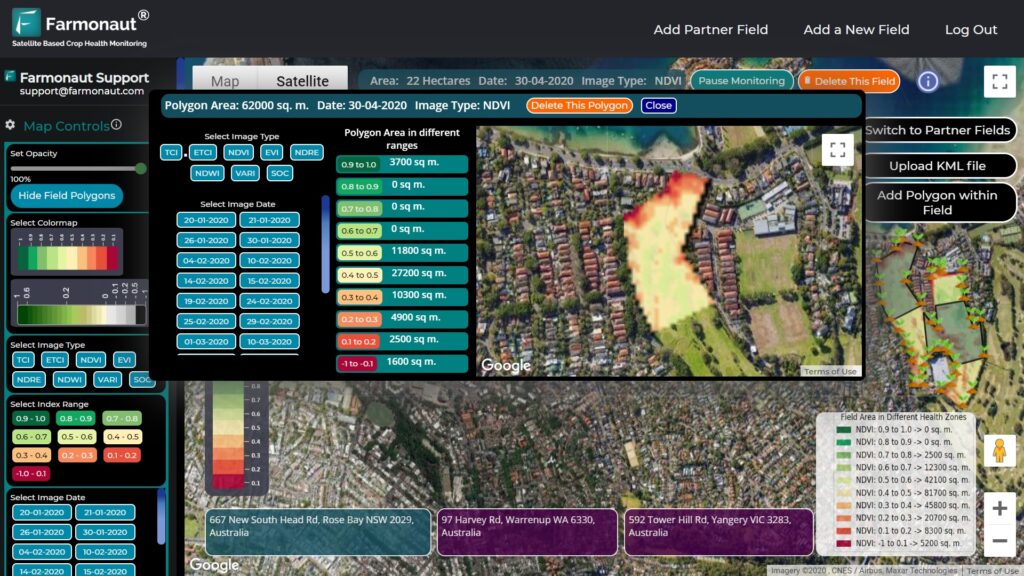Federal Agency Workforce Cuts: 7 Oregon Ag Impacts
“USDA workforce cuts could affect over 1,200 Oregon agricultural jobs, impacting food safety and rural economic stability.”
Table of Contents
- Overview: Federal Workforce Reductions in Agriculture
- The 7 Major Impacts on Oregon Agriculture
- Federal Agency Cuts – Visual Overview
- Impact by Sector Comparison Table
- Agricultural Research Funding Cuts & Food Safety Risks
- FSA County Offices, Farming Services, and Farmer Assistance
- Forest Management and Wildfire Risks in Oregon
- Impact of Layoffs on Oregon’s Rural Economies
- Public Safety and Environmental Conservation Threats
- Climate Adaptation in Oregon Agriculture
- USDA Response & Mitigation Strategies
- Farmonaut’s Technology: Supporting Resilience
- FAQ: Federal Workforce Reductions in Oregon Ag
- Farmonaut Subscriptions
- Conclusion
“Federal agency reductions may delay $50 million in annual financial aid to Oregon’s farmers and forest managers.”
Overview: Federal Workforce Reductions in Agriculture
Over the past few years, the United States has undergone significant federal workforce reductions in agriculture. These cuts have directly impacted the United States Department of Agriculture (USDA), the Forest Service (USFS), and several county offices across Oregon. The scale of these layoffs is unprecedented in recent memory, especially considering the vital roles these agencies play in supporting farmers, forest management, food safety, and the economic resilience of rural states like Oregon.
In early 2025, roughly 5,600 USDA personnel were dismissed, affecting areas like the Farm Service Agency (FSA), Natural Resources Conservation Service (NRCS), and USFS. The FSA, key to financial assistance for farmers and farm management, lost 1,100 county staff. These departures are not limited to back-end staff; county offices remain open but with thinned ranks, causing concern in the agricultural sector.
As we examine the impact of layoffs on rural economies, food safety, public safety, forestry, and environmental conservation in Oregon, our goal is to present a comprehensive, factual overview of the challenges and strategies shaping our local and national agricultural policy landscape.
Watch: How Digital Tools Like Farmonaut Support Precision Agriculture
Farmonaut’s platform offers satellite imagery and AI-driven insights to help Oregon farmers manage fields and monitor their carbon footprint, which is especially relevant as federal research and outreach funding tightens. Their large-scale farm management tools help agribusinesses track operations—even as federal support resources fluctuate.
The 7 Major Impacts: Oregon Agriculture & USDA Workforce Cuts
- Food Safety and Contaminant Prevention Weakened
- Financial Assistance for Farmers Delayed
- Forest Management and Wildfire Risks Intensify
- Loss of Specialized County Office Services
- Public Safety at Infrastructure Sites Degraded
- Agricultural Research and Innovation Stalled
- Impact of Layoffs on Rural Economies & Population Trends
These critical areas reflect both immediate service disruptions and longer-term changes to the structure of agriculture, forestry, and conservation initiatives in Oregon and beyond.
Impact by Sector Comparison Table: Federal Workforce Reductions in Oregon Ag
| Sector | Estimated Workforce Reduction (%) | Projected Short-term Impact | Projected Long-term Impact |
|---|---|---|---|
| Food Safety Inspection (ARS, USDA) | -14% | Fewer foodborne pathogen checks; delays in nutrition fraud detection. | Increased risk of contaminant outbreaks; slowed adaptation to emerging threats. |
| Financial Aid Services (FSA, County Offices) | -22% | Aid application delays; slower loan and insurance approvals. | Reduced farm investment capability; higher risk of farm bankruptcies. |
| Forest Management (USFS) | -10% | Less wildfire prevention; deferred forest restoration. | Larger, more frequent wildfires; ecosystem degradation. |
| Rural Development Services | -9% | Delays in technical assistance; slower project rollouts. | Population loss; lower economic growth rates. |
| Public Safety (Bureau of Reclamation) | -12% | Reduced dam inspections, delayed repairs. | Increased risk of infrastructural failure and environmental incidents. |
This table provides a sector-by-sector breakdown of recent USDA and federal workforce reductions in agriculture, specifically highlighting Oregon’s most affected areas.
Farmonaut’s automated detection systems help identify alternate wet and dry farming phases, which is vital as federal technical assistance is stretched thin by staff losses.
Agricultural Research Funding Cuts & Food Safety Risks
One of the most acute effects of federal workforce reductions in agriculture is felt in the realm of food safety and agricultural research. The Agricultural Research Service (ARS) lost a significant portion of its scientists focused on contaminant prevention and foodborne illness detection. Oregon, a state synonymous with specialty crops, grains, and organic produce, relies heavily on ongoing research to ensure food safety and meet international market standards.
- Food Safety Impact: With fewer ARS staff, there is less surveillance for foodborne illnesses and chemical/biological contaminants across the food supply. The loss of research capacity increases risk for both domestic consumers and export markets.
- Research Gaps: ARS departures slow nutrition fraud prevention, the study of pathogens, and necessary climate adaptation in agriculture. Fewer Oregon scientists can attend conferences or communicate about field-level impacts, stifling innovation at a critical time.
- Climate Resilience: In the face of a changing climate, ARS and USDA-led research is essential for developing crop varieties and management practices resilient to more variable weather, pests, and disease pressures.
FSA County Offices, Farming Services, and Farmer Assistance
While USDA leaders assure Oregonians that no FSA County Offices will close, these offices are now operating with up to one-fifth fewer staff. For Oregon’s 37,000+ farms, these offices are a critical access point for:
- Financial assistance for farmers – Disaster programs, direct and guaranteed loans, farm insurance, and climate-focused adaptation grants
- Technical support – Conservation, risk management, and nutritional programs
- Resource management – Guidance on soil health, irrigation, and environmental compliance
Impact of Staff Cuts
- Delays in processing farm aid, insurance claims, and loan applications—sometimes for months
- Reduced outreach to minority, beginner, and specialty crop farmers
- Backlogs in climate and resource conservation program sign-ups
- Slower technical support response, increasing risk of missed planting or harvest windows
Oregon’s FSA county offices serve as the backbone for rural stability. Reduced capacity means increased wait times and heightened uncertainty at the farm level.
To help Oregon farmers adapt, Farmonaut offers satellite-based verification for crop loans and insurance. This strengthens access to credit and insurance even during times of FSA staff attrition.
Forest Management and Wildfire Risks in Oregon
In a state where forestry and conservation are central to both economy and identity, USFS layoffs carry particular weight. The dismissal of 3,400 Forest Service staff—nearly 10% of the agency—has left Oregon forests with fewer rangers, probationary firefighters, and technical support staff at precisely the moment climate-driven fire risks are peaking.
- Forest Management Gaps: Essential duties such as fuel reduction, hazardous debris removal, and trail upkeep are being deferred or canceled. The result is higher wildfire vulnerability across the West—especially in high-risk regions of Oregon.
- Support for Wildland Firefighters: With diminished USFS staffing, recruiting, training, and supporting Oregon’s seasonal fire crews becomes far more difficult.
- Conservation Impact: Federal workforce reductions in forestry directly impede endangered species protection, habitat restoration, and long-term natural resources management challenges.
Forest stakeholders (timber, wildlife, recreation, rural communities) all face increased uncertainty as management backlogs grow.
Farmonaut’s remote sensing tools deliver ongoing forest health assessments, helping industry and government plan for wildfire mitigation and resource conservation, even amidst staffing shortages.
Impact of Layoffs on Oregon’s Rural Economies
The impact of layoffs on rural economies extends far beyond agricultural production. Oregon’s non-urban counties depend on federal agency employment: USDA, FSA, NRCS, USFS, and support agencies constitute a foundation for economic activity, educational outreach, and infrastructure management.
Consequences of Workforce Reductions
- Loss of high-quality jobs, especially in smaller towns where alternatives are limited
- Reduced local spending and business activity, with ripple effects through Main Street economies
- Lower property and sales tax revenues, putting local services at risk
- Population declines as experienced workers migrate out for new opportunities, often with families in tow
This economic contraction threatens both the sustainability of rural communities and Oregon’s reputation as a leader in agricultural innovation and forest products. The knock-on effects can also be seen in secondary industries such as tourism, recreation, and ecosystem services.
For farmers, Farmonaut’s fleet management solutions offer efficient vehicle and machinery tracking, reducing operational costs and supporting economic sustainability—even during budgetary uncertainty.
With diminished government technical assistance, precision agriculture powered by Farmonaut’s satellite platform helps Oregon growers monitor fields and maximize yields despite resource constraints.
Public Safety and Environmental Conservation Threats
Staffing cuts at agencies like the Bureau of Reclamation pose material risks to public safety in Oregon and the greater Pacific Northwest. Bureau layoffs included nearly 400 dam operators, engineers, and emergency managers, with further reductions anticipated.
- Dam and Hydro Infrastructure: Less frequent inspections at crucial water and hydropower facilities (such as major Reclamation-operated dams) increases the risk of costly, even catastrophic, failures.
- Environmental Conservation: The shortage of agency scientists and engineers slows down habitat restoration and emergency preparedness, undermining resilience in water-stressed and fire-prone rural areas.
In a climate that is already trending drier and more extreme, this loss of institutional knowledge can make the difference between a prepared community and an avoidable disaster.
Climate Adaptation in Oregon Agriculture
The United States—Oregon included—must address climate adaptation in agriculture as unprecedented weather patterns, droughts, and pest pressures challenge traditional farming methods.
With the double blow of agricultural research funding cuts and fewer technical support personnel, Oregon’s climate adaptation strategies are at a crossroads:
- Slower Dissemination: Breakthroughs in drought-tolerant crop varieties, regenerative practices, and soil health management may take longer to reach growers.
- Resource Limitations: Reduced NRCS staff slows the distribution of climate-smart subsidies, delaying implementation of water-saving and carbon-smart practices.
- Advisory Backlogs: Time-sensitive decisions on irrigation, fertilizer, and pesticide application depend on timely advice—now more limited due to workforce reductions.
To empower adaptation, Farmonaut’s carbon footprint tracking allows Oregon agribusinesses to monitor their environmental impact, improving decision-making and compliance with emerging regulations—even with federal agencies stretched thin.
USDA Response & Mitigation Strategies
The USDA has initiated steps to refill critical vacancies and prevent further impacts to food safety, forest management, and rural economic stability:
- Active recruitment for FSA county-level positions, wildland firefighters, and critical Animal & Plant Health Inspection Service (APHIS) staff
- Online technical assistance rollouts to reduce demand on in-person staff
- Streamlined aid application portals and digital solutions to accelerate financial aid for farmers
However, the transition is slow. Hundreds of incentive-based departures have been blocked from essential posts—these are the very positions Oregon’s agricultural, forestry, and rural economic sectors rely on most, leaving ongoing service gaps.
Politically, litigation has led to federal courts temporarily reversing some mass firings and calling on agencies to reinstate key staff members. The legal fight underscores the stakes for communities that depend on trained, experienced personnel for support and safety.
Farmonaut’s Technology: Supporting Resilience Amid Federal Cuts
As federal agencies adjust to reduced staffing and increased demands, technology-driven platforms like Farmonaut take on a greater role in ensuring the sustainability of agriculture, forestry, and rural development in Oregon and nationwide.
Here’s how Farmonaut’s solutions address key challenges:
- Real-Time Crop Health Monitoring: Satellite-based imagery empowers Oregon’s producers to spot issues in the field, enabling prompt, data-driven decisions despite less federal technical outreach.
- Fleet and Resource Management: Fleet management tools optimize operations, saving on fuel and labor in a climate of reduced subsidies and advisory services.
- Product Traceability: Blockchain-based supply chain solutions fulfill market traceability requirements as USDA export services become less accessible.
- Carbon Footprinting: Farmers and agribusinesses track emissions, contributing to both corporate sustainability goals and new carbon markets when agency guidance is slow.
- API Access: Institutions and developers can enhance farm management systems using the Farmonaut API and explore documentation at Farmonaut Satellite Weather API Docs.
Watch how Farmonaut® brings advanced data to large-scale agricultural management, supporting Oregon’s evolving crop landscape in times of uncertainty.
FAQ: Federal Workforce Reductions and Oregon Agriculture
1. How do federal workforce reductions affect Oregon agriculture?
Reductions in USDA and USFS staffing mean fewer services at county offices, delayed financial aid, slower response to food safety threats, and increased wildfire risks—directly affecting Oregon’s farming, forestry, and rural economies.
2. What is happening at Oregon’s FSA county offices?
While all county offices remain open, most have reduced staff, causing delays in aid applications, conservation sign-ups, and technical assistance for farmers.
3. How are food safety and research impacted?
Loss of ARS scientists means less capacity for research into foodborne illnesses, contaminants, and fraud—putting both public health and Oregon’s export markets at additional risk.
4. Can technology support Oregon farmers as federal services shrink?
Yes. Platforms like Farmonaut offer satellite-based monitoring, digital advisory tools, loan and insurance verification, and traceability—helping fill service gaps and empower data-driven decision-making.
5. Are there still USDA conservation programs for climate adaptation?
Yes, but program rollouts and approvals are slower due to workforce cuts. Digital solutions and private-sector tools are increasingly important for rapid adoption.
Conclusion: The Road Ahead for Oregon’s Agriculture Post-Federal Cuts
In summary, recent federal workforce reductions in agriculture have touched every corner of Oregon’s food, farming, and forestry landscape. The most profound consequences include:
- Weakening food safety and contaminant prevention
- Delays and uncertainties around financial assistance for farmers
- Escalating forest management and wildfire risks
- Smaller, less responsive county offices and public safety threats
- Stalled innovation from agricultural research funding cuts
- Erosion of rural economies, jobs, and environmental conservation programs
- Slower climate adaptation in agriculture
For Oregon, investment in digital tools and modern agricultural technology, such as those provided by Farmonaut, is essential to future-proofing the sector. From traceability for food exports to satellite-verified crop insurance and AI-driven crop advisory, Oregon’s agricultural leaders have a growing toolkit to maintain productivity and resilience—even as federal support ebbs and flows.
The path forward lies in a partnership between public investment, technology adoption, and community-driven solutions, ensuring the economic and environmental health of Oregon and the broader agricultural landscape for generations to come.
Explore how data-driven agriculture can help Oregon adapt. Try Farmonaut Now or build custom solutions with the Farmonaut API.
















